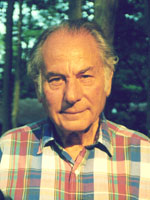
Ernest L. Eliel
University of North Carolina at Chapel Hill
A Stereochemical Merger
Stereochemistry has its origins in the middle of the nineteenth century with chemists Louis Pasteur, Joseph Le Bel, and Jacobus Henricus van’t Hoff. The field was very active in the second half of the nineteenth century but declined in activity in the first half of the twentieth. Stereochemistry changed again around 1950 with the pioneering work of my mentors: Derek H. R. Barton, who worked on conformation, and Vladimir Prelog, whose research centered on configuration. In 1962 I published the first modern English text on organic stereochemistry, followed by four related coauthored books and a series called
Topics in Stereochemistry coedited by Norman L. Allinger and first published in 1967.
In 1965 I attended the first of what are now the annual EUCHEM Conferences on Stereochemistry (or the Bürgenstock Conferences) held in an elegant hotel on a bluff overlooking Lake Lucerne in Switzerland. Only a few Americans are invited to these yearly conferences, and so I felt it desirable to initiate a Stereochemistry Conference in the United States. This plan had the full support of my fellow stereochemist Kurt Mislow (Princeton University). However, a complication arose: in 1975 James Morrison (University of New Hampshire), Donald Valentine (Hoffmann-La Roche), and Albert I. Meyers (Colorado State University) initiated the Asymmetric Synthesis Gordon Conference. Morrison chaired the 1975 conference and Valentine the next one in 1978. Both Mislow and I felt that this was too narrow an area for a sustained conference, but we also realized it would not be acceptable to have a second Gordon Conference in the general area of stereochemistry. Thus, with the active help of Al Meyers and Gordon Conference board member David Lemal, we persuaded the originators of the Asymmetric Synthesis Conference to merge it into a broader Stereochemistry Conference, with the 1978 conference first taking the name and myself taking on the responsibilities of vice chair.
Of the twelve talks at the 1975 conference eleven were on stereoselective synthesis. By 1978, with some input from the vice chair, only seven of the thirteen lectures were on that subject. By 1980, when I was chair, the incidence of stereoselective talks had dropped to four out of thirteen, as it was my intent to present a very broad view of the field. In 1982, under the chairmanship of Al Meyers, the percentage rose again to almost half and has stayed at near half ever since. This is probably as it should be, for although stereoselective synthesis is not the be-all and end-all of stereochemistry, it is probably the subject of greatest interest to the substantial number of attendees from the pharmaceutical industry (which has supported the conference financially over the years).
Poster sessions were first added to the 1980 conference; eighteen posters were presented, and posters have been included ever since. Generous financial support from the Gordon Conference board over the years made it possible to defray conference fees for a number of young attendees, in addition to the lecturers and discussion leaders. Total attendance in 1980 was 123; in the last two decades it has fluctuated between 80 and 129.
The Stereochemistry Conference now takes place every two years. Occupation of the chair has generally oscillated between industrial and academic chemists. In addition to stereoselective synthesis subjects now cover such broad areas as nuclear magnetic resonance spectroscopy, optical rotation and circular dichroism, molecular mechanics, inorganic and bioorganic stereochemistry, crystallography, macromolecular chemistry, and other subjects, including green chemistry. In 1986 and 1990 molecular modeling workshops were also held. The breadth of the conference is its strength, since it brings together chemists from many areas to inject new points of view.
From 1975 to 1986 the Stereochemistry Conference was held at Plymouth State College in New Hampshire’s White Mountains, and afternoons were often devoted to mountain climbing or swimming. In 1988 the conference moved to more comfortable quarters at Salve Regina College in Newport, Rhode Island, where afternoons tend to be divided between recreation and poster sessions or workshops.
I have attended all but one of the Stereochemistry Conferences in the last twenty-five years and have always found them interesting and enjoyable.